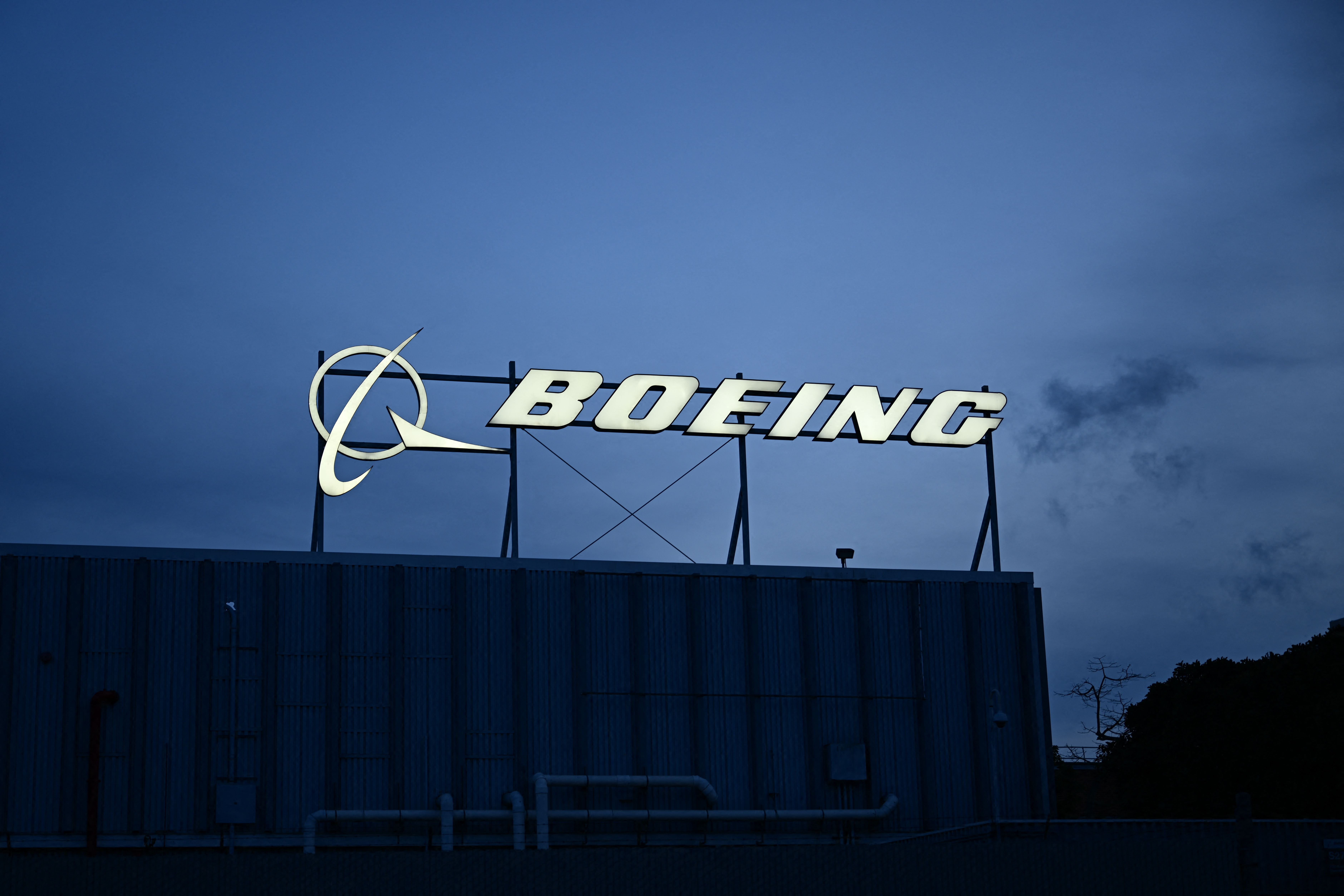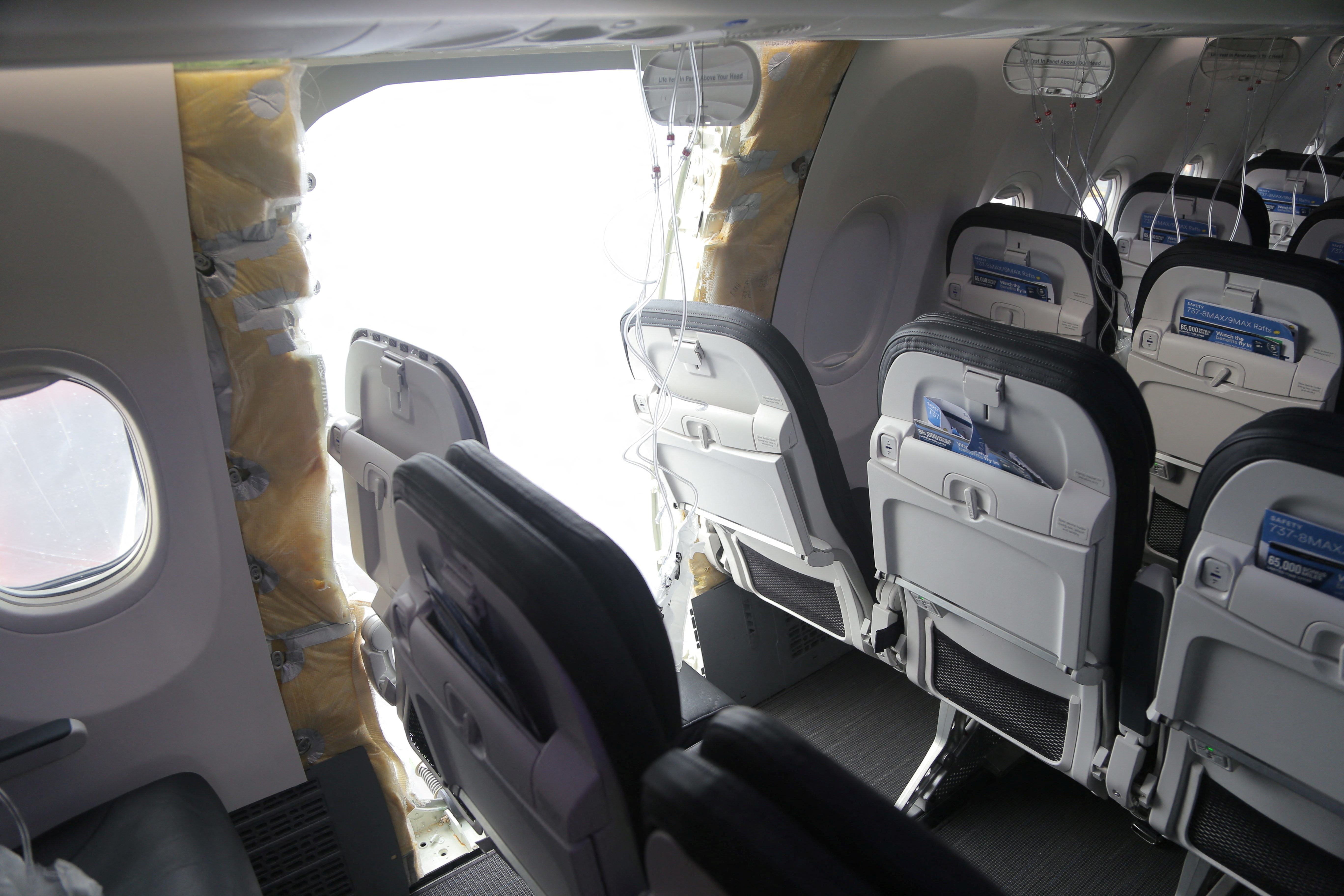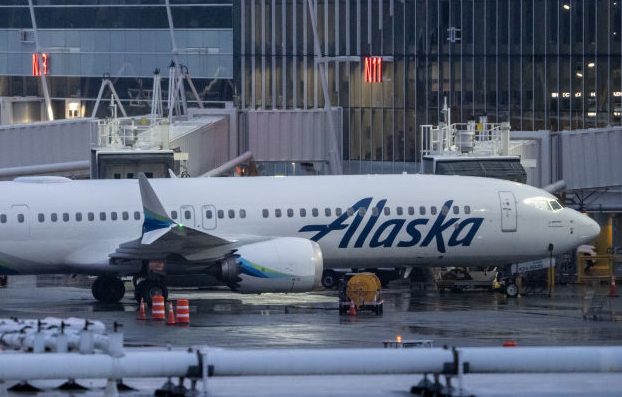
When an Alaska Airlines Boeing 737-9 made an emergency landing in Portland on January 5 following a door plug blowing out shortly after departure, alarm bells began to ring.
For Boeing, this was another incident on its 737 MAX series and one that it simply could not afford to happen.
Across the last half-decade, the trust in the manufacturer from the flying public has dropped significantly. Boeing’s gap in market share with rival European aircraft manufacturer Airbus, a direct competitor, has widened considerably following fewer orders and deliveries per year.
Boeing’s current position has been attributed to several factors, including poor quality control, a race to secure profits and more. Analysts and former employees that Al Jazeera spoke to pinned the decline on the company’s culture, which has created a schism between management and employees on the factory floor for some time – the 737-9 crisis being only the latest symptom of the continuing problem.
The Alaska Airlines flight
Flight AS1282, with service between Portland and Ontario, departed on January 5 like any other scheduled flight. However, shortly after departure, the aircraft, a 737-9 from the MAX family, suffered a pressurisation issue from the rear mid-cabin exit door plug separating.
The aircraft departed Portland at 17:06:59 and reached a maximum altitude of 16,325 feet (4,976 metres) per Flightrdar24 data at 17:13:41, with a descent beginning shortly after. All on board the aircraft escaped safely, with minor injuries that were cleared by medical examiners.
Dr William Bensinger, an aviation medical examiner, told The Seattle Times that had this happened at cruising altitude, more than double the altitude of when the blowout occurred, the results might have been dramatically different.
That night, Alaska Airlines temporarily grounded its fleet of 65 737-9s, calling it a precautionary move. The next day the Federal Aviation Administration (FAA) issued an Emergency Airworthiness Directive (EAD) that ensured 171 737-9s across multiple airlines with plug doors were grounded for inspections and possible maintenance.
The National Transportation Safety Board (NTSB) has launched an investigation to determine why an exit door that is meant to be locked in place was able to blow out.

Loose bolts uncovered
With the EAD issued, airline technicians began preliminary checks on their parked 737-9s.
Highlighting that it was not exclusively an Alaska Airlines problem, Alaska Airlines was the second airline to identify loose bolts in the inspection. Hours before, United Airlines became the first to identify loose bolts, discovering them on up to five 737-9s, according to the Air Current. The two airlines identifying quality issues dealt a new blow to Boeing.
Boeing’s CEO, Dave Calhoun, acknowledged mistakes made by the manufacturer and identified the incident as a “quality escape” when speaking to CNBC. Calhoun noted that this describes what was found in inspections, with the loose bolts and other issues being “something that escaped from the manufacturing process.”
Following Caloun’s comments, the FAA launched a formal investigation into Boeing’s production practices and said it would look “to determine if Boeing failed to ensure completed products confirmed to its approved design and were in a condition for safe operation in compliance with FAA regulations”.
Boeing is legally required to meet the safety standards laid out to them, and the FAA has expressed concerns about whether these are met on several occasions even before the January 5 incident.
On January 13, Alaska Airlines announced its quality and audit team will do a thorough review of Boeing’s quality and control systems. Alaska remains the only airline to announce a formal review of Boeing’s internal processes.
Inside Boeing, a culture change

Internally, upper management across the last decade has prioritised delivering aircraft to customers as soon as possible.
These targets, laid out by senior executives at Boeing, were deemed unrealistic by those working on the aircraft. As a result, employees felt pressured to meet deadlines that were not possible without corners being cut.
Per a now-retired Boeing employee, who declined to be named and who worked with the 737 MAX and was on the floor, the immense pressure affected staff morale and work quality.
Overtime was a regular occurrence across all teams to get the planes in the air as soon as possible. On several occasions, the former employee worked 10-12-hour days across a multi-year period in the mid to late 2010s, longer than the typical timeframe for his role of up to eight hours. These overtime shifts were followed by lengthy weekend shifts occurring for month-long periods.
Before the latest quality lapses were identified, Boeing, in December 2023, requested the inspection of 737 MAX aircraft for potential loose bolts in the rudder control system. This followed an unnamed international operator reporting loose bolts during scheduled maintenance and Boeing discovering an improperly tightened nut on an undelivered jet in the same month.
Quality issues also appeared in August 2023 when Boeing found an issue involving Spirit AeroSystems, one of its key suppliers. These quality drops were traced back to holes on the aft pressure bulkhead that were improperly drilled, as reported by The Air Current.
Boeing’s drop in quality has been attributed to several factors. For the 737 MAX, a race to compete with Airbus and their A320neo saw this aircraft launched on a fuselage that analysts argued had reached its limitations.
A culture already on the downturn only increased as the disconnect between staff on the floor and in the offices grew. Those building the aircraft and other similar roles, such as detailing, believed that senior executives lacked understanding of the importance and time associated with their work. This lack of understanding was often attributed to a race for profits and stock market focus.
Cornell Beard, the president of The International Association of Machinists and Aerospace Workers, told The Wall Street Journal that continued pressure on employees could be pushing quality control to suffer. He added, “We have planes all over the world that have issues that nobody has found because of the pressure Spirit has put on employees to get the job done so fast”.
These employees on the floor at the height of the 2019 737 MAX crisis felt betrayed that their senior management preached safety and quality, but prioritised getting planes in the air.
Following 737 MAX groundings occurring over 21 months from March 2019, and a global pandemic that saw air travel demand plummet, Boeing laid off staff close to retirement age, offering buyout packages.
However, as pandemic-related restrictions eased and Boeing faced growth in the sector again, the gap between ages and, thus, the experience of seniors and juniors grew, with the latter taking a more substantial role.
Boeing scrambled to get this experience back as pressures increased on the floor: Retired workers were enticed to return to the manufacturer to oversee key manufacturing processes. Some refused, citing the negative work environment, including the retired employee.
Boeing did not respond to Al Jazeera’s request for comment.
Boeing attempts to fix culture

On January 15, Boeing revealed a five-point plan to ensure quality, including increasing quality inspections throughout the building process. While there has been a 20 percent increase in inspectors since 2019, that has not been sufficient.
The plane maker also announced additional sessions focusing on understanding the fundamentals of Boeing’s quality management system (QMS).
Boeing supplier Spirit will also come under the microscope. Boeing plans to inspect more than 50 points in the build process to assess whether these line up against key engineering specifications. Spirit declined to comment on how many total build processes exist.
Boeing has also confirmed it will open its doors for additional oversight inspections from customers who want to review production and quality procedures better.
Lastly, the manufacturer has named retired US Navy Admiral Kirkland H Donald, as an adviser. Donald and a team of outside experts will conduct a thorough assessment of Boeing’s quality management.
Boeing hopes that transparency and these additional measures can rebuild trust from airline customers, the flying public and onlookers.
But Richard Aboulafia, managing director of AeroDyanmic Advisory, called these changes “meaningless and superficial”.
Aboulafia said that until there is a cultural adjustment, nothing much will change. “They need to restore the connection between the people at the top of the company and the people responsible for building and designing aircraft,” he said.
To achieve these steps, Aboulafia said Boeing needed to focus on bringing more people with technical knowledge into the higher ranks, rather than prioritising investor returns. Without that change, the plane maker will “simply lurch from crisis to crisis, with more band-aids designed to temporarily restore a modicum of confidence”, he said.
Among the first steps towards getting the 737-9s that remain grounded back in service, Boeing provided a multi-operator message (MOM) to the FAA for approval. These MOMs contain instructions for companies on the relevant inspection procedures that will eventually complete certifications to allow the plane back in the skies.
The FAA received an initial version of an MOM from Boeing on January 8, but asked the company to revise it. Once final revisions arrive on FAA desks, the pair can conduct a formal review, and then affected airlines will be able to carry out the relevant work. There’s no timeline for the return to service of the 737-9, with the FAA prioritising safety over speed.
Even when the Boeing 737-9s affected by the EAD resume service, Boeing will face several questions, including how quality escapes continue to hamper their aircraft.
The year 2024 was initially earmarked as a year Boeing needed to continue rebuilding its reputation. However, the plane maker has been scrambling a little more than three weeks into the new year to limit damage. While the 737-9 can return to service, investigations into production practices will continue, leaving room for further potential findings.
Boeing’s troubles got worse this week when the FAA recommended on January 21 that operators of the Boeing 737-900ER visually inspect the mid-exit door plugs on their aircraft. The 737-900ER shares the same door plug design as the grounded 737-9. However, it is not from the 737 MAX series but rather its predecessor.
Ultimately, two remaining variants of the MAX series, the 737-7 and 737-10, are still uncertified. Additionally, Boeing is racing to meet a 2025 entry into service for its new long-haul 777X. But with its focus now on its latest troubles, the two remaining variants may have to wait some more time for their certification.







